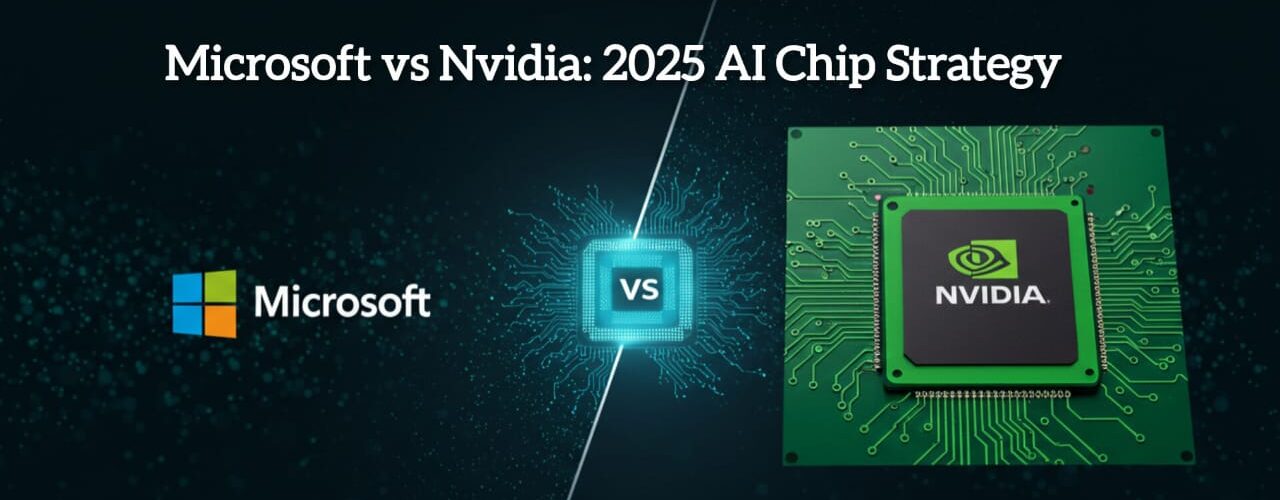Artificial Intelligence has reached a stage where the limits of progress are no longer defined by algorithms alone. In 2025, the greatest bottleneck is hardware — specifically, the availability of advanced GPUs and high-performance computing infrastructure. Against this backdrop, Microsoft, under the leadership of CEO Satya Nadella and Microsoft AI CEO Mustafa Suleyman, has taken a decisive step: investing billions into in-house AI chip clusters.
This move reflects a profound shift in strategy. Instead of relying on Nvidia, whose GPUs have dominated AI training for nearly a decade, Microsoft is building a sovereign infrastructure ecosystem designed to power the next generation of frontier models. The decision is not simply technical — it has geopolitical, economic, and organizational implications that could redefine the global AI race.
The Bottleneck: AI’s Dependence on Nvidia
For most of the 2020s, Nvidia has enjoyed near-monopoly status in AI compute. Its H100 and B200 GPUs became the gold standard for training large language models, with hyperscalers and startups alike competing for limited supply. This scarcity translated into skyrocketing costs, long procurement cycles, and heavy dependency on a single vendor.
For Microsoft — whose Azure cloud platform underpins not only its own AI services but also external clients such as OpenAI — this dependency represented a strategic vulnerability. If supply chains were disrupted or geopolitical restrictions tightened, the company’s ability to train and deploy competitive models could be compromised.
Nadella’s response has been to pursue compute sovereignty, an approach where Microsoft controls the entire AI stack, from hardware to models to deployment environments.
Microsoft’s Custom Chip Strategy
At the core of this strategy is the Athena chip program, Microsoft’s custom AI accelerator project. While Athena chips have been in development for several years, 2025 marks the first time Microsoft is scaling production into dedicated hyperscale clusters.
Key Features of the Approach
- Vertical Integration
By designing its own chips, Microsoft can tightly couple hardware with its proprietary models. This enables optimizations at the instruction-set level, reducing latency and improving throughput for large-scale inference. - Cost Control
Building custom chips lowers long-term reliance on Nvidia’s premium pricing. Even if initial R&D costs are high, at hyperscale deployments the unit economics shift favorably. - Tailored Compute
Instead of designing for general workloads, Microsoft can optimize clusters for specific tasks such as training foundation models or powering Copilot features across Office, GitHub, and Windows. - Geopolitical Hedge
Developing in-house hardware reduces exposure to export restrictions on advanced GPUs, a critical consideration as U.S.–China tech tensions continue.
Mustafa Suleyman’s Role
The appointment of Mustafa Suleyman, co-founder of DeepMind and Inflection AI, as Microsoft AI CEO in 2024 provided a strong technical and strategic vision for this pivot. Suleyman has consistently emphasized that AI companies cannot rely indefinitely on third-party supply chains if they intend to scale models toward artificial general intelligence (AGI).
Under his leadership, Microsoft’s AI roadmap integrates hardware sovereignty with model innovation. While the company’s MAI-1 foundation model is still trailing behind some competitors in raw performance, Suleyman has argued that the long-term differentiator will be infrastructure scalability rather than benchmark supremacy.
Implications for the AI Industry
Microsoft’s move to sovereign compute infrastructure will reverberate across the global AI ecosystem in several ways:
- Pressure on Competitors
Amazon and Google will face heightened pressure to accelerate their own in-house chip programs (Trainium, Inferentia, TPU) to avoid falling behind. - Impact on Nvidia
While Nvidia’s dominance is unlikely to collapse overnight, hyperscaler defections could erode its pricing power and weaken its long-term market share. - Barrier for Startups
Smaller firms will struggle to access affordable compute as hyperscalers hoard capacity. This may reinforce centralization, where only trillion-dollar firms can train frontier models. - Energy and Sustainability
Large-scale clusters demand vast energy resources, creating new challenges for sustainability and forcing partnerships with renewable providers.
Connections to Decentralization and Web3
Interestingly, Microsoft’s centralization strategy could accelerate counter-movements in decentralized compute markets. Web3 projects are exploring ways to pool GPU resources across distributed networks, offering alternatives to hyperscaler dominance.
For example, decentralized GPU marketplaces allow smaller organizations to train and run models without building billion-dollar data centers. While these solutions are far from rivaling Microsoft in scale, they represent an important innovation frontier — one that intersects with developments we track in our Crypto News section.
The contrast between centralized hyperscaler infrastructure and decentralized compute ecosystems highlights the dual trajectories of AI’s future: consolidation by tech giants, and experimentation by open networks.
Educational Value: Why This Matters for AI Learners
For those studying or working in AI, Microsoft’s chip sovereignty strategy offers several lessons:
- Systems Thinking: AI is not just about algorithms. Success increasingly depends on integrating hardware, software, and energy.
- Infrastructure Awareness: Developers must understand the physical limits of compute — training models is constrained by chips, clusters, and power grids.
- Geopolitical Context: Export restrictions, supply chain politics, and national investments in semiconductors will directly shape AI’s trajectory.
- Adaptability: As major firms consolidate compute, individuals and smaller teams may need to explore open-source and decentralized approaches to remain competitive.
For deeper insights into how AI education must adapt to these dynamics — including learning about hardware bottlenecks, regulatory frameworks, and future workforce skills — explore our AI Education section
Satya Nadella’s decision to invest in sovereign AI chip clusters marks one of the most significant inflection points in the 2025 AI race. By moving away from Nvidia dependency, Microsoft is betting on vertical integration as the foundation of its long-term strategy.
This gamble carries risks — from massive upfront costs to potential technological setbacks — but the potential rewards are transformative. If successful, Microsoft will not only secure its place as a leader in AI but also reshape the competitive landscape, forcing rivals to follow suit.
Ultimately, Nadella’s gamble underscores a deeper truth: the future of AI will not be determined solely by clever algorithms or elegant architectures, but by who controls the compute. And in a world where power, infrastructure, and innovation are tightly coupled, those who master hardware sovereignty may hold the keys to the next era of artificial intelligence.







